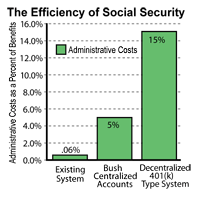January/February 2005 IBEW Journal
(First in a Series)
It was a simple idea that enveloped
generations of Americans in a retirement of security.
No longer would working men and women face economic
uncertainty in their waning years, wondering whether
disease or financial misfortune would leave them
destitute, a burden upon their children or society.
Social Security would be insurance against lifes
risks: a reliable, monthly base income calculated
on age, salary and the number of years in the work
force.
Social Security has been a promise and a fair deal
for millions of Americans since it began in 1935. In
exchange for payroll taxes withheld from each paycheck,
workers understood the government would pay them a
benefit upon retirement.
But now, the most popular government program ever
created is on the table for discussion and possible
radical change, put there by President George W. Bush.
President Bushs initial plan to restructure Social
Security was derailed by the September 11 attacks and
the war in Iraq. Now, with a second term in hand and
a perceived supply of political capital, he has made
reforming Social Security the centerpiece of his domestic
agenda.
Social Security promises to be the burning economic
issue in the United States for the next two years.
The popular program was once considered politically
untouchable, but now President Bush and many of his
supporters think that sentiment among the public, especially
younger workers, may have changed enough to make changespackaged
under the label of reformpossible.
This issue of the IBEW Journal went to press before
the President announced his final proposal for changing
Social Security. According to press reports, the key
elements of his plan will be allowing workers to divert
part of their payroll taxes into private accounts and
changing the formula under which benefits are calculated.
The impact of these and other changes on retirees,
especially retired working people, would be huge.
This article is the first of several that will examine
the Social Security system and discuss proposed changes.
Social Security
Through the Years
Even for those who have private savings or pensions,
Social Security is a vital source of income. To many,
Social Security is considered the third and most important
leg of the three-legged stool upon which a stable retirement
rests. The other "legs" consist of personal
savings and employer-provided pension plans. From age
65 on (phasing in at higher ages fro those born post-World
War II), recipients receive a fixed, lifelong, inflation-adjusted
monthly check. (Social Security is also a disability
and life insurance program, with about a third of its
benefits going toward those purposes.) It is the largest
source of retirement income for all but the wealthiest
Americans.
"Social Security is the only one of the three
legs that is both guaranteed by the government and
indexed for inflation," said IBEW International
President Ed Hill. "Social Security forms the
cornerstone of almost everyones retirement in the
United States."
|
A
Stable Retirement Rests
On a Three-Legged Foundation

Social Security is the only
one
of the three legs that is guaranteed
by the government and indexed for inflation. |
Conceived during the Depression to protect workers
from economic disaster in old age, Social Security
is widely viewed as the cornerstone program of the
New Deal of President Franklin D. Roosevelt. Social
Security is given credit for virtually eliminating
the grinding poverty that had been the fate of many
elderly Americans. A recent analysis by The Wall Street
Journal found that half of Americas elderly rise above
the poverty line only because of Social Security checks.
St. Louis Local 633 retiree DeForrest Cline said he
remembers the skepticism among his coworkers at the
time that Social Security was implemented. "All
the middle aged people said they would never collect
a dime on that," said Cline, who is 86. "They
couldnt be happier now."
Having bargained for retiree pensions, many IBEW members
face retirement with more financial resources than
the population at large. But a dwindling number of
employers offer pensions; even those who do are having
trouble fulfilling that obligation to workers.
"With Social Security, I can buy my medicine
and still eat," said retired Local 11 member Robert
Armstrong. "Its not really a luxury. It enables
me to pay the electric bill."
That was the idea behind Social Security. Arthur Altmeyer,
one of Social Securitys architects, described it as
providing an individual "some measure of protection
when he is tossed about by economic forces beyond his
control." In the early years of the 21st century,
there exists at least as much insecurity as when the
program began. Today, health insurance and Medicare
do not insulate the elderly from rising health care
costs. In fact, a December study released by the Kaiser
Family Foundation concluded that retirees who receive
health benefits from former employers saw their premiums
increase by an average of 25 percent in 2004. Housing,
medication, taxes, food and utility costs are all expenses
that do not cease at retirement. Consequently, American
workers are always expected to have some additional
savings to maintain their standard of living in retirement.
Armstrong, 77, said he is fortunate that 40 years
in the trades earned him a lifestyle that allowed he
and his wife to raise seven children and retire in
relative comfort. "I sure consider myself lucky
as retirees go," said Armstrong, who lives in
Ramona, California. "I dont want Mr. Bush messing
with Social Security."
What are personal retirement accounts?
President Bush proposes to replace part of the current
Social Security system with personal investment accounts.
Such a privatization plan would allow individuals to
direct the portion of their payroll (FICA) taxes that
go into the Social Security trust fund into investment
vehicles of the persons own choice.
To accomplish this overhaul, the administration has
acknowledged the need for what it calls "up-front
transition financing." These up-front costs have
been estimated at between $1 and $5 trillion. The $7.5
trillion national debthigher than ever and growing
daily from the cost of two wars, upper-bracket tax
cuts and a yawning trade deficitwould be further exacerbated.
Heaping debt upon debt is already starting to erode
international confidence in the dollar; such immense
borrowing for Social Security could lead the United
States into an economic tailspin.
 The
loss of guaranteed Social Security benefits would be
a striking blow to workers. Although benefit cuts would
be phased in over time, IBEW Pension Benefit Fund Director
Larry Reidenbach said to make up for the loss of income,
an individual would have to save an additional $250,000
to replace Social Security. But that would be unlikely
for most Americans, who are not known for their propensity
to save. "Most people are not saving anywhere
near that, period, much less more to replace Social
Security," he said. The
loss of guaranteed Social Security benefits would be
a striking blow to workers. Although benefit cuts would
be phased in over time, IBEW Pension Benefit Fund Director
Larry Reidenbach said to make up for the loss of income,
an individual would have to save an additional $250,000
to replace Social Security. But that would be unlikely
for most Americans, who are not known for their propensity
to save. "Most people are not saving anywhere
near that, period, much less more to replace Social
Security," he said.
Right now, Social Security is efficiently operated,
with administrative costs at less than 1 percent. Privatizing
would certainly increase the costs of running the program.
About 15 cents on every dollar paid out in benefits
goes to administer Englands private retirement accounts
program.
More>>
|
